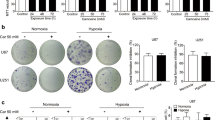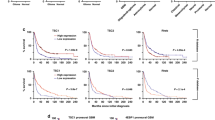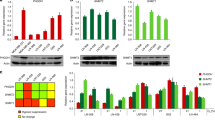Abstract
Glioma tumors are refractory to conventional treatment. Glioblastoma multiforme is the most aggressive type of primary brain tumors in humans. In this study, we introduce oxidative stress-energy depletion (OSED) therapy as a new suggested treatment for glioblastoma. OSED utilizes D-amino acid oxidase (DAO), which is a promising therapeutic protein that induces oxidative stress and apoptosis through generating hydrogen peroxide (H2O2). OSED combines DAO with 3-bromopyruvate (3BP), a hexokinase II (HK II) inhibitor that interferes with Warburg effect, a metabolic alteration of most tumor cells that is characterized by enhanced aerobic glycolysis. Our data revealed that 3BP induced depletion of energetic capabilities of glioma cells. 3BP induced H2O2 production as a novel mechanism of its action. C6 glioma transfected with DAO and treated with D-serine together with 3BP-sensitized glioma cells to 3BP and decreased markedly proliferation, clonogenic power and viability in a three-dimensional tumor model with lesser effect on normal astrocytes. DAO gene therapy using atelocollagen as an in vivo transfection agent proved effective in a glioma tumor model in Sprague–Dawley (SD) rats, especially after combination with 3BP. OSED treatment was safe and tolerable in SD rats. OSED therapy may be a promising therapeutic modality for glioma.
This is a preview of subscription content, access via your institution
Access options
Subscribe to this journal
Receive 12 print issues and online access
$259.00 per year
only $21.58 per issue
Buy this article
- Purchase on Springer Link
- Instant access to full article PDF
Prices may be subject to local taxes which are calculated during checkout












Similar content being viewed by others
References
Reardon DA, Wen PY . Therapeutic advances in the treatment of glioblastoma: rationale and potential role of targeted agents. Oncologist 2006; 11: 152–164.
Kawazoe T, Park HK, Iwana S, Tsuge H, Fukui K . Human D-amino acid oxidase: an update and review. Chem Rec 2007; 7: 305–315.
Dale DC, Boxer L, Liles WC . The phagocytes: neutrophils and monocytes. Blood 2008; 112: 935–945.
Stegman LD, Zheng H, Neal ER, Ben-Yoseph O, Pollegioni L, Pilone MS et al. Induction of cytotoxic oxidative stress by D-alanine in brain tumor cells expressing Rhodotorula gracilis D-amino acid oxidase: a cancer gene therapy strategy. Hum Gene Ther 1998; 9: 185–193.
Wilson JE . Isozymes of mammalian hexokinase: structure, subcellular localization and metabolic function. J Exp Biol 2003; 206: 2049–2057.
Paggi MG, Fanciulli M, Del Carlo C, Citro G, Carapella CM, Floridi A . The membrane-bound hexokinase as a potential marker for malignancy in human gliomas. J Neurosurg Sci 1990; 34: 209–213.
Nakashima RA, Paggi MG, Pedersen PL . Contributions of glycolysis and oxidative phosphorylation to adenosine 5′-triphosphate production in AS-30D hepatoma cells. Cancer Res 1984; 44: 5702–5706.
Pedersen PL . The cancer cell's ‘power plants’ as promising therapeutic targets: an overview. J Bioenerg Biomembr 2007; 39: 1–12.
Warburg O . On the origin of cancer cells. Science 1956; 123: 309–314.
Michelakis ED, Sutendra G, Dromparis P, Webster L, Haromy A, Niven E et al. Metabolic modulation of glioblastoma with dichloroacetate. Sci Transl Med 2010; 2: 31–34.
Shaw RJ . Glucose metabolism and cancer. Curr Opin Cell Biol 2006; 18: 598–608.
Mazurek S, Boschek CB, Eigenbrodt E . The role of phosphometabolites in cell proliferation, energy metabolism, and tumor therapy. J Bioenerg Biomembr 1997; 29: 315–330.
Gambhir SS . Molecular imaging of cancer with positron emission tomography. Nat Rev Cancer 2002; 2: 683–693.
Mineura K, Yasuda T, Kowada M, Sakamoto T, Ogawa T, Shishido F et al. Positron emission tomographic evaluations in the diagnosis and therapy of multifocal glioblastoma. Report of a pediatric case. Pediatr Neurosci 1986; 12: 208–212.
Spence AM, Muzi M, Graham MM, O’Sullivan F, Krohn KA, Link JM et al. Glucose metabolism in human malignant gliomas measured quantitatively with PET, 1-[C-11] glucose and FDG: analysis of the FDG lumped constant. J Nucl Med 1998; 39: 440–448.
Geschwind JH, Ko YH, Torbenson MS, Magee C, Pedersen PL . Novel therapy for liver cancer: direct intraarterial injection of a potent inhibitor of ATP production. Cancer Res 2002; 62: 3909–3913.
Park HK, Shishido Y, Ichise-Shishido S, Kawazoe T, Ono K, Iwana S et al. Potential role for astroglial D-amino acid oxidase in extracellular D-serine metabolism and cytotoxicity. J Biochem 2006; 139: 295–304.
Urai Y, Jinnouchi O, Kwak KT, Suzue A, Nagahiro S, Fukui K . Gene expression of D-amino acid oxidase in cultured rat astrocytes: regional and cell type specific expression. Neurosci Lett 2002; 324: 101–104.
Ihrlund LS, Hernlund E, Khan O, Shoshan MC . 3-Bromopyruvate as inhibitor of tumour cell energy metabolism and chemopotentiator of platinum drugs. Mol Oncol 2008; 2: 94–101.
Altinoz MA, Bilir A, Ozar E, Onar FD, Sav A . Medroxyprogesterone acetate alone or synergistic with chemotherapy suppresses colony formation and DNA synthesis in C6 glioma in vitro. Int J Dev Neurosci 2001; 19: 541–547.
Friedrich J, Seidel C, Ebner R, Kunz-Schughart LA . Spheroid-based drug screen: considerations and practical approach. Nat Protoc 2009; 4: 309–324.
Abou El-Magd RM, Park HK, Kawazoe T, Iwana S, Ono K, Chung SP et al. The effect of resperidone on D-amino acid oxidase activity as a hypothesis for a novel mechanism of action in the treatment of schizophrenia. J Psychopharmacol 2010; 24: 1055–1067.
Ko YH, Pedersen PL, Geschwind JF . Glucose catabolism in the rabbit VX2 tumor model for liver cancer: characterization and targeting hexokinase. Cancer Lett 2001; 173: 83–91.
Pytel P . Spectrum of pediatric gliomas: implications for the development of future therapies. Expert Rev Anticancer Ther 2007; 7: 51–60.
Fang J, Seki T, Maeda H . Therapeutic strategies by modulating oxygen stress in cancer and inflammation. Adv Drug Deliv Rev 2009; 61: 290–302.
Grobben B, De Deyn PP, Slegers H . Rat C6 glioma as experimental model system for the study of glioblastoma growth and invasion. Cell Tissue Res 2002; 310: 257–270.
Nagamatsu S, Nakamichi Y, Inoue N, Inoue M, Nishino H, Sawa H . Rat C6 glioma cell growth is related to glucose transport and metabolism. Biochem J 1996; 319: 477–482.
Ikezaki K, Black KL, Conklin SG, Becker DP . Histochemical evaluation of energy metabolism in rat glioma. Neurol Res 1992; 14: 289–293.
Machida K, Ohta Y, Osada H . Suppression of apoptosis by cyclophilin D via stabilization of hexokinase II mitochondrial binding in cancer cells. J Biol Chem 2006; 281: 14314–14320.
Pedersen PL . Voltage dependent anion channels (VDACs): a brief introduction with a focus on the outer mitochondrial compartment's roles together with hexokinase-2 in the ‘Warburg effect’ in cancer. J Bioenerg Biomembr 2008; 40: 123–126.
da-Silva WS, Gomez-Puyou A, de Gomez-Puyou MT, Moreno-Sanchez R, De Felice FG, de Meis L et al. Mitochondrial bound hexokinase activity as a preventive antioxidant defense: steady-state ADP formation as a regulatory mechanism of membrane potential and reactive oxygen species generation in mitochondria. J Biol Chem 2004; 279: 39846–39855.
Yang MS, Yu LC, Gupta RC . Analysis of changes in energy and redox states in HepG2 hepatoma and C6 glioma cells upon exposure to cadmium. Toxicology 2004; 201: 105–113.
Makino N, Mise T, Sagara J . Kinetics of hydrogen peroxide elimination by astrocytes and C6 glioma cells: analysis based on a mathematical model. Biochim Biophys Acta 2008; 1780: 927–936.
Smith TA . Mammalian hexokinases and their abnormal expression in cancer. Br J Biomed Sci 2000; 57: 170–178.
Pelicano H, Martin DS, Xu RH, Huang P . Glycolysis inhibition for anticancer treatment. Oncogene 2006; 25: 254633–254646.
Lee KH, Park JH, Won R, Lee H, Nam TS, Lee BH . Inhibition of hexokinase leads to neuroprotection against excitotoxicity in organotypic hippocampal slice culture. J Neurosci Res 2011; 89: 96–107.
Kantrowitz JT, Malhotra AK, Cornblatt B, Silipo G, Balla A, Suckow RF et al. High dose D-serine in the treatment of schizophrenia. Schizophr Res 2010; 121: 125–130.
Starkov AA, Fiskum G . Regulation of brain mitochondrial H2O2 production by membrane potential and NAD(P)H redox state. J Neurochem 2003; 86: 1101–1107.
McEligot AJ, Yang S, Meyskens FLJR . Redox regulation by intrinsic species and extrinsic nutrients in normal and cancer cells. Annu Rev Nutr 2005; 25: 261–295.
Korshunov SS, Skulachev VP, Starkov AA . High protonic potential actuates a mechanism of production of reactive oxygen species in mitochondria. FEBS Lett 1997; 416: 15–18.
Kim JS, Ahn KJ, Kim JA, Kim HM, Lee JD, Lee JM et al. Role of reactive oxygen species-mediated mitochondrial dysregulation in 3-bromopyruvate induced cell death in hepatoma cells: ROS-mediated cell death by 3-bromopyruvate. J Bioenerg Biomembr 2008; 40: 607–618.
Simons AL, Mattson DM, Dornfeld K, Spitz DR . Glucose deprivation-induced metabolic oxidative stress and cancer therapy. J Cancer Res Ther 2009; 5: 2–6.
Qin JZ, Xin H, Nickoloff BJ . 3-Bromopyruvate induces necrotic cell death in sensitive melanoma cell lines. Biochem Biophys Res Commun 2010; 396: 495–500.
Tsai KL, Wang SM, Chen CC, Fong TH, Wu ML . Mechanism of oxidative stress-induced intracellular acidosis in rat cerebellar astrocytes and C6 glioma cells. J Physiol 1997; 502: 161–174.
Hyslop PA, Hinshaw DB, Halsey Jr WA, Schraufstätter IU, Sauerheber RD, Spragg RG et al. Mechanisms of oxidant-mediated cell injury: the glycolytic and mitochondrial pathways of phosphorylation are major intracellular targets inactivated by hydrogen peroxide. J Biol Chem 1988; 263: 1665–1675.
Appelskog IB, Ammerpohl O, Svechnikova IG, Lui WO, Almqvist PM, Ekström TJ . Histone deacetylase inhibitor 4-phenylbutyrate suppresses GAPDH mRNA expression in glioma cells. Int J Oncol 2004; 24: 1419–1425.
Mazurek S, Boschek CB, Eigenbrodt E . The role of phosphometabolites in cell proliferation, energy metabolism and tumor therapy. J Bioenerg Biomembr 1997; 29: 315–330.
Zong WX, Ditsworth D, Bauer DE, Wang ZQ, Thompson CB . Alkylating DNA damage stimulates a regulated form of necrotic cell death. Genes Dev 2004; 18: 1272–1282.
Proskuryakov SY, Konoplyannikov AG, Gabai VL . Necrosis: a specific form of programmed cell death? Exp Cell Res 2003; 283: 1–16.
Segel IH . Enzyme activation. In: Segel IH (ed). Enzyme kinetics: Behaviour and analysis of rapid equilibrium and steady-state enzyme systems, 1st edn. John Wiley & Sons: Inc. New York, 1993, pp 227–272.
Chung SP, Sogabe K, Park HK, Song Y, Ono K, Abou El-Magd RM et al. Potential cytotoxic effect of hydroxypyruvate produced from D-serine by astroglial D-amino acid oxidase. J Biochem 2010; 148: 743–753.
Robey RB, Hay N . Mitochondrial hexokinases, novel mediators of the antiapoptotic effects of growth factors and Akt. Oncogene 2006; 25: 4683–4696.
Kim W, Yoon JH, Jeong JM, Cheon GJ, Lee TS, Yang JI et al. Apoptosis-inducing antitumor efficacy of hexokinase II inhibitor in hepatocellular carcinoma. Mol Cancer Ther 2007; 6: 2554–2262.
Kowaltowski AJ, Castilho RF, Vercesi AE . Opening of the mitochondrial permeability transition pore by uncoupling or inorganic phosphate in the presence of Ca2+ is dependent on mitochondrial-generated reactive oxygen species. FEBS Lett 1996; 378: 150–152.
Watanabe K, Sakamoto M, Somiya M, Amin MR, Kamitani H, Watanabe T . Feasibility and limitations of the rat model by C6 gliomas implanted at the subcutaneous region. Neurol Res 2002; 24: 485–490.
Ko YH, Smith BL, Wang Y, Pomper MG, Rini DA, Torbenson MS et al. Advanced cancers: eradication in all cases using 3-bromopyruvate therapy to deplete ATP. Biochem Biophys Res Commun 2004; 324: 269–275.
Acknowledgements
This work was supported by a Grant-in-Aid for Scientific Research from the Ministry of Education, Science, Sports and Culture of Japan. Cell lines used for this study were provided by BioResource room, The Institute for Enzyme Research, The University of Tokushima, Japan. We thank Y Okamura in Support Center for Advanced Medical Sciences, Institute of Health Biosciences, The University of Tokushima for assistance in flow cytometric analysis. We also appreciate Dr Young H Ko for her kind advice on 3BP dosage for in vivo study.
Author information
Authors and Affiliations
Corresponding author
Ethics declarations
Competing interests
The authors declare no conflict of interest.
Rights and permissions
About this article
Cite this article
El Sayed, S., Abou El-Magd, R., Shishido, Y. et al. D-amino acid oxidase gene therapy sensitizes glioma cells to the antiglycolytic effect of 3-bromopyruvate. Cancer Gene Ther 19, 1–18 (2012). https://doi.org/10.1038/cgt.2011.59
Received:
Revised:
Accepted:
Published:
Issue Date:
DOI: https://doi.org/10.1038/cgt.2011.59
Keywords
This article is cited by
-
Perillyl alcohol and its synthetic derivatives: the rising of a novel class of selective and potent antitumoral compounds
Medicinal Chemistry Research (2022)
-
Effect of methyl jasmonate and 3-bromopyruvate combination therapy on mice bearing the 4 T1 breast cancer cell line
Journal of Bioenergetics and Biomembranes (2020)
-
OMICfpp: a fuzzy approach for paired RNA-Seq counts
BMC Genomics (2019)
-
Effect of 3-bromopyruvate acid on the redox equilibrium in non-invasive MCF-7 and invasive MDA-MB-231 breast cancer cells
Journal of Bioenergetics and Biomembranes (2016)
-
The anticancer agent 3-bromopyruvate: a simple but powerful molecule taken from the lab to the bedside
Journal of Bioenergetics and Biomembranes (2016)



